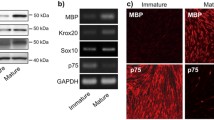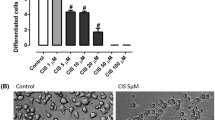Abstract
Suramin is a polyanionic chemotherapeutic agent which causes severe peripheral neuropathy. The mechanisms of antineoplastic and neurotoxic activities are still poorly understood. Interference with growth factor receptor function has been suggested for suramin's chemotherapeutic function. Previous studies from our laboratory have demonstrated that suramin interfered with the function of nerve growth factor (NGF) and induced lysosomal storage defects within dorsal root ganglion neurons. Pentosan polysulfate (PPS) was used as another polyanionic agent, to compare these two cellular functions; NGF receptor interaction and disruption in glycolipid metabolism. Like suramin and NGF, PPS induced neurite outgrowth from the PC12 cell line which correlated with tyrosine phosphorylation of the high affinity NGF receptor (TrkA/gp140) and ERK-1/MAP kinase. Ultrastructural studies of dorsal root ganglion exposed to PPS for various time periods were normal. This contrasted with suramin exposed cultures which consistently developed lamellar inclusion bodies (LIB) within 6 h. LIB formation with suramin treatment was associated with neuronal cell death, while PPS treatment did not cause any neurotoxic effects. These results indicated that PPS mimicked the effect of suramin on NGF receptors but did not cause similar accumulation of LIB. This suggested that the effect of polyanionic compounds on TrkA was not involved in LIB accumulation and subsequent induction of neurotoxicity.
Similar content being viewed by others
References
Hosang M: Suramin binds to platelet-derived growth factor and inhibits its biological activity. J Cell Biochem 29: 265-273, 1985
Coffey RJ, Leof EB, Shipley GD, Moses HL: Suramin inhibition of growth factor receptor binding and mitogenicity in AKR-2B cells, J Cell Physiol 132: 143-148, 1987
Oliver S, Formento P, Fischel JL, Etienne MC, Milano G: Epidermal growth factor receptor expression and suramin cytotoxicity in vitro. Eur J Cancer 26: 867-871, 1990
LaRocca RV, Meer J, Gilliatt RW, Stein CA, Cassidy J, Myers CE, Dalakas MC: Suramin-induced polyneuropathy. Neurology 40: 954-960, 1990
Arora R, Dhand UK, Kobayashi K, Vokes EE, Martin B, Janisch L, Ratain MJ, Soliven B: Evaluation of neuropathy in patients on suramin treatment. Neurology 44(Suppl 2): A306, 1994 Abstract
Russell JW, Windebank AJ, Podratz JL: Role of nerve growth factor in suramin neurotoxicity studied in vitro. Ann Neurol 36: 221-228, 1994
Gill JS, Hobday KL, Windebank AJ: Mechanism of suramin toxicity in stable myelinating dorsal root ganglion cultures. Exp Neurol 133: 113-124, 1995
Gill JS, Connolly DC, McManus MJ, Maihle NJ, Windebank AJ: Suramin induces phosphorylation of the high-affinity nerve growth factor receptor in PC12 cells and dorsal root ganglion neurons. J Neurochem 66: 963-972, 1996
Gill JS, Windebank AJ: Suramin is both a partial agonist and competitive inhibitor for the high affinity NGF receptor. Ann Neurol 38: 308, 1995 Abstract
Paul R, Herbert JM, Maffrand JP. Lansen J, Modat G, Pereillo JM, Gordon JL: Inhibition of vascular smooth muscle cell proliferation in culture by pentosan polysulphate and related compounds. Thromb Res 46: 793-801, 1987
Combe DR, Parish CR, Ramshaw IA, Snowden IM: Analysis of the inhibition of tumour metastasis by sulphated polysaccharides. Int J Cancer 39: 82-88, 1987
MacGregor IR, Dawes J, Pepper DS, Prowse CV, Stocks J: Metabolism of sodium pentosan polysulphate in man measured by a new competitive binding assay for sulphated polysaccharides — comparison with effects upon anticoagulant activity, lipolysis and platelet a granule proteins. Thromb Haemost 53: 411-414, 1985
Delvos U, Paul JE, Müller-Berghaus G: Effect of the heparinoid pentosan polysulphate (SP 54) on the functional properties of cultured bovine aortic endothelial cells. Blut 51: 127-136, 1985
MacGregor IR, Dawes J, Paton L, Pepper DS, Prowse CV, Smith M: Metabolism of sodium pentosan polysulphate in man — catabolism of iodinated derivatives. Thromb Haemost 51: 321-325, 1984
Nguyen NM, Lehr JE, Pienta KJ: Pentosan inhibits angiogenesis in vitro and suppresses prostate tumor growth in vivo. Anticancer Res 13: 2143-2147, 1993
Pienta KJ, Murpphy BC, Isaacs WB, Isaacs JT, Coffey DS: Effect of pentosan, a novel cancer chemotherapeutic agent, on prostate cancer cell growth and motility. Prostate 20: 233-241, 1992
Herbet JM. Cottineau M. Driot F. Pereillo Jm. Maffrand JP: Activity of pentosan polysulphate and derived compounds on vascular endothelial cell proliferation and migraton induced by acidic and basic FGF in vitro. Biochem Pharmacol 37: 4281-4288, 1988
Sydow G, Klöcking H-P: Effect of pentosan polysulfate (SP 54) on the reverse transcriptase activity of several retroviruses. Biomed Biochem Acta 46: 527-530, 1987
Pienta KJ, Isaacs WB, Vindivich D, Coffey DS: The effects of basic fibroblast growth factor and suramin on cell motility and growth of rat prostate cancer cells. J Urol 145: 199-202, 1991
Swain S, Wellstein A, Parker B, Lippman M, Steakley C, DeLap R: Heparin-binding growth factor blockade with pentosan polysulfate. Ann N Y Acad Sci 698: 63-70, 1993
Wellstein A, Zugmaier G, Califano JA III, Kern F, Paik S, Lippman ME: Tumor growth dependent on Kaposi's sarcoma-derived fibroblast growth factor inhibited by pentosan polysulfate. J Natl Cancer Inst 83: 716-720, 1991
Zugmaier G, Lippman ME, Wellstein A: Inhibition by pentosan polysulfate (PPS) of heparin-binding growth factors released from tumor cells and blockage by PPS of tumor growth in animals. J Natl Cancer Inst 84: 1716-1724, 1992
Conti AM, Fischer SJ, Windebank AJ: Inhibition of axonal growth from sensory neurons by excess nerve growth factor. Ann Neurol 1997 (in press)
Windebank AJ, Blexrud MD: Characteristics of neurite outgrowth from rat spinal ganglia: effects of serum and segmental level. J Neuropathol Exp Neurol 45: 683-691, 1986
Batistatou A, Greene LA: Internucleosomal DNA cleavage and neuronal cell survival/death. J Cell Biol 122: 523-532, 1993
Stein CA, LaRocca RV, Thomas R, McAtee N, Myers CE: Suramin: an anticancer drug with a unique mechanism of action. J Clin Oncol 7: 499-508, 1989
LaRocca RV, Stein CA, Myers CE, Dalakas M, McAtee N: Suramin induced acute polyneuropathy. Proc Annu Meet Am Soc Clin Oncol 8: 71, 1989 Abstract
Stein CA: Suramin: a novel antincoplastic agent with multiple potential mechanisms of action. Cancer Res 53: 2239-2248, 1993
Pluda JM, Shay LE, Foli A, Tannenbaum S, Cohen PJ, Goldspiel BR, Adamo D, Cooper MR, Broder S, Yarchoan R: Administration of pentosan polysulfate to patients with human immunodeficiency virus-associated Kaposi's sarcoma. J Natl Cancer Inst 85: 1585-1592, 1993
Parker BW, Swain SM, Zugmaier G, DeLap RL, Lippman ME, Wellstein A: Detectable inhibition of heparin-binding growth factor activity in sera from patients treated with pentosan polysulfate. J Natl Cancer Inst 85: 1068-1073, 1993
Rees S, Constantopoulos G, Barranger JA, Brady RO: Organomegaly and histopathology in an animal model of mucopolysaccharidosis induced by suramin. Naunyn Schmiedebergs Arch Pharmacol 319: 262-270, 1982
Constantopoulos G, Rees S, Cragg BG, Barranger JA, Brady RO: Effect of suramin on the activities of degradative enzymes of sphingolipids in rats. Res Commun Chem Pathol Pharmacol 32: 87-97, 1981
Constantopoulos G, Rees S, Cragg BG, Barranger JA, Brady RO: Suramin-induced storage disease Mucopolysaccharidosis. Am J Pathol 113: 266-268, 1983
Author information
Authors and Affiliations
Rights and permissions
About this article
Cite this article
Gill, J.S., Windebank, A.J. Activation of the high affinity nerve growth factor receptor by two polyanionic chemotherapeutic agents: Role in drug induced neurotoxicity. J Neurooncol 40, 19–27 (1998). https://doi.org/10.1023/A:1006051126333
Issue Date:
DOI: https://doi.org/10.1023/A:1006051126333




